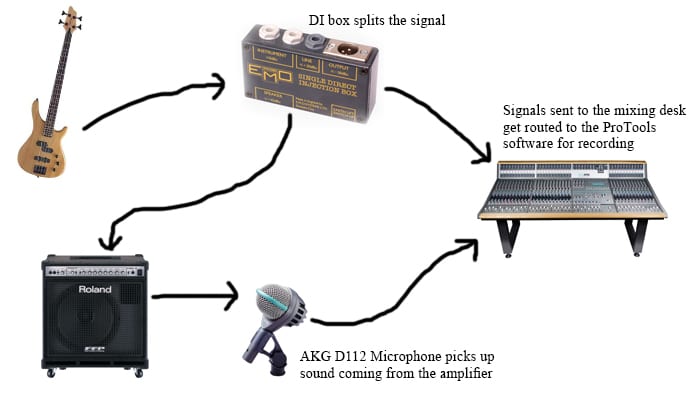Setup
During week 7, we had to record the bass parts for our multitrack project. Our bass player, Zoe, was to play the bass within the live room. Her bass was connected to a DI box. The DI box allowed the signal to be split and sent in two directions. One signal went straight to the mixing desk. From the mixing desk, the signal could be sent to ProTools so that it may be recorded. This signal will be a clean recording of the bass guitar. The second signal was sent to an amplifier. An AKG D112 microphone was placed in front of the amplifier. The AKG D112 has a low frequency range, meaning it is well suited for picking up the sound of a bass guitar. Below this is a basic diagram of the setup so far.
The Microphone was placed so that it could pick up the truest sound. A sound is described as ‘true’ when it sounds most like how the human ear would hear it before being recorded. To get this true sound, the microphone was placed close up to the speaker, halfway accross the radius of the soundcone. A diagram of this microphone placement can be seen below.
Next we placed a microphone in front of Zoe and routed it to the mixing desk for talkback. We then made sure that Zoe could hear the backing track clearly and that she was comfortable with the levels of the individual tracks being sent to her headset. Once that was done, we made sure to set the levels of her bass on the mixing desk. Once they were set, we were ready to start recording.
The Recording Process
This week I have learned of a new recording technique. Instead of having Zoe repeat the song until we recorded a perfect take, we used a new function called ‘quick punch’. This recording tool within ProTools allows us to record over existing audio at any point of a take by quickly clicking on the record button. This allowed us to rewind takes and record over any mistakes that were made.
And that’s that. Two bass tracks were recorded by the end of te session. One was a clean take that could be edited and have plugins and effects added to it at a later date. The other was recorded with effects already set on an amplifier.
